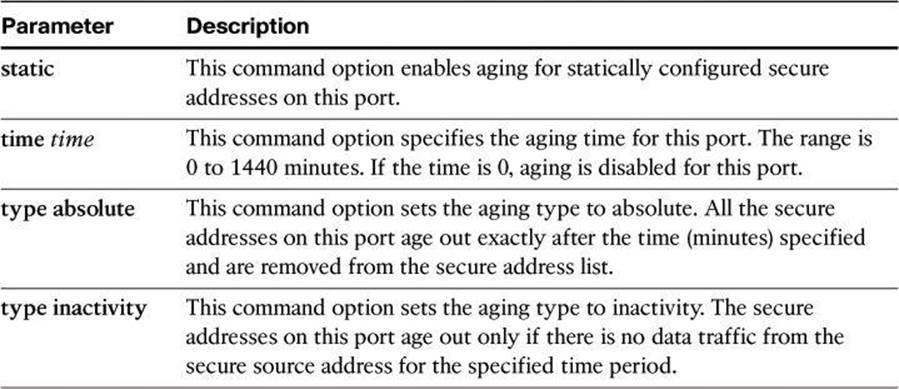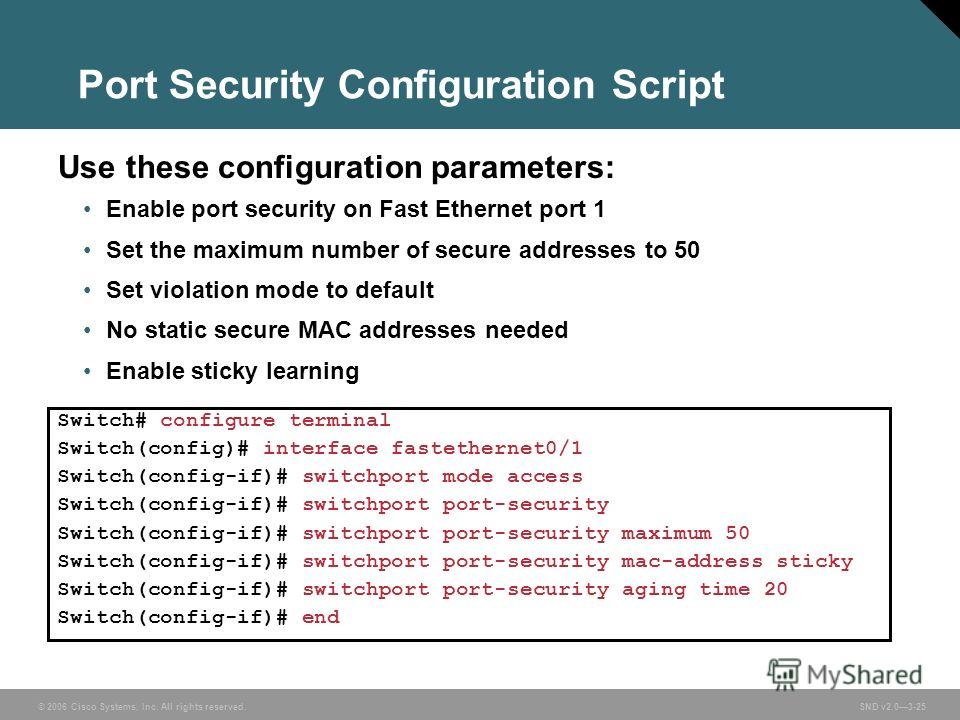

- How to set static mac address learning in cisco how to#
- How to set static mac address learning in cisco serial#
- How to set static mac address learning in cisco verification#
OTGSwitch(config-if)# switchport port-security maximum 2 Configure violation mode Sometimes you need a maximum of two devices to attach to a switch port. However you may want to modify the above default settings to suit your needs which is explained next. Aging is disabled and so learned MAC addresses do not expire even after the host is disconnected. If violation occurs then the port goes to shutdown (error-disabled) state. I.e, Only one MAC address is allowed to connect to the port. The default settings for port security are:

OTGSwitch(config-if)# switchport port-security OTGSwitch(config-if)# switchport mode access To turn it on, on any of the switch interfaces: Port security can only be configured on access ports. Also you can restict too many devices sharing connection to one of the switch ports by attaching to hubs or other dumb switches. This feauture can typically be used if your switch is in a public area where it is possible for people to pull out cables and plug in to your switch ports etc. However you should plan beforehand which ports are to be secured, how many MACs are allowed on these ports, should the MACs be static or dynamic and what action to perform if the restriction is violated. By configuring port security you can make sure that only certain MAC addresses are allowed to connect to certain switch ports and if others are detected, these ports can be shutdown.
How to set static mac address learning in cisco verification#
R2 will forward al the packets intended for 1.0.0.0 network to its next hop address which is 12.1.1.1.įor verification you can ping 1.1.1.1 from router R2 and 2.2.2.2 from router R1.Port security is one of the methods for restricting unauthorized access to your switch ports. Notice the “S” in R2 routing table, it denotes static route, 1.0.0.0/8 is the network which is accessible through 12.1.1.1. %SYS-5-CONFIG_I: Configured from console by console Configuring Static Route on R2: R2>enableĮnter configuration commands, one per line. R1 will forward al the packets intended for 2.0.0.0 network to its next hop address which is 12.1.1.2. Notice the “S” in R1 routing table, it denotes static route, 2.0.0.0/8 is the network which is accessible through 12.1.1.2. Configuring Static Route on R1: R1(config)# If we want R2 to forward packets to subnet 2.0.0.0 then we need to configure a static route. Routing table of R2 shows that subnets 2.0.0.0 and 12.0.0.0 are directly connected and can be pinged but subnet 1.0.0.0 cannot be accessed as it is directly connected to R1 and not to R2. R2(config-if)# ip address 2.2.2.2 255.0.0.0Ĭheck Routing Table of router R2: R2#show ip routeĬ 2.0.0.0/8 is directly connected, Loopback0Ĭ 12.0.0.0/8 is directly connected, Serial0/1/1 Basic Configuration of R2: Router> enable If we want R1 to forward packets to subnet 2.0.0.0 then we need to configure a static route.

Routing table of R1 shows that subnets 1.0.0.0 and 12.0.0.0 are directly connected and can be pinged but subnet 2.0.0.0 cannot be accessed as it is directly connected to R2 and not to R1. * - candidate default, U - per-user static route, o - ODRĬ 1.0.0.0/8 is directly connected, Loopback0Ĭ 12.0.0.0/8 is directly connected, Serial0/1/0

I - IS-IS, L1 - IS-IS level-1, L2 - IS-IS level-2, ia - IS-IS inter area N1 - OSPF NSSA external type 1, N2 - OSPF NSSA external type 2Į1 - OSPF external type 1, E2 - OSPF external type 2, E - EGP R1(config-if)# ip address 1.1.1.1 255.0.0.0Ĭhecking Routing Table of router R1: R1#show ip routeĬodes: C - connected, S - static, I - IGRP, R - RIP, M - mobile, B - BGPĭ - EIGRP, EX - EIGRP external, O - OSPF, IA - OSPF inter area
How to set static mac address learning in cisco how to#
We have explained the functionality of DCE and DTE in more details in how to set clock rate on Cisco router. DCE interface provides the clocking to the routers connected through it.
How to set static mac address learning in cisco serial#
You should note that when connecting two routers through serial cable, the serial interface of one router must be configured as DCE(Data Communication Equipment). We will demonstrate adding static routes with the help of two routers, router R1 and router R2, and three subnets 12.0.0.0, 1.0.0.0 and 2.0.0.0. By adding a static route, a router can be told how to send or forward packets to the subnets that are not directly attached.


 0 kommentar(er)
0 kommentar(er)
